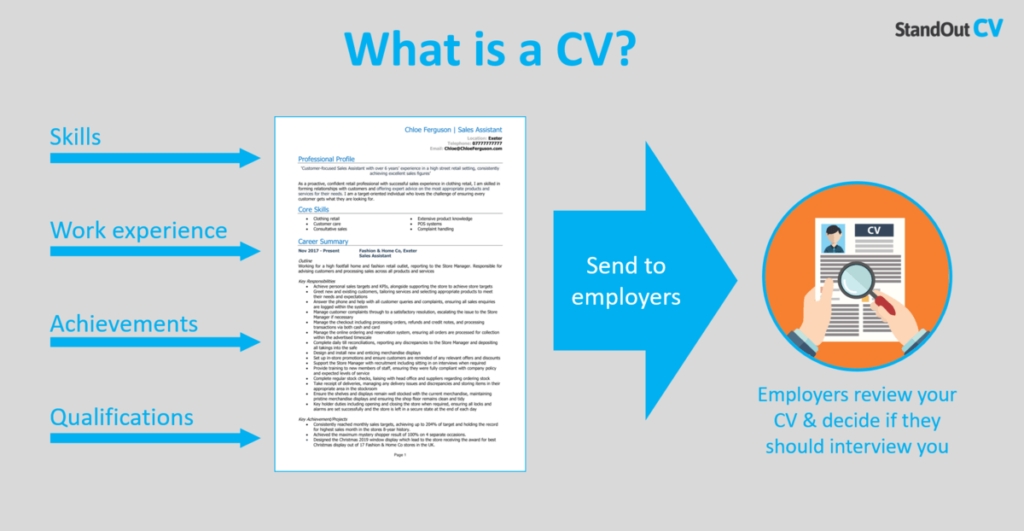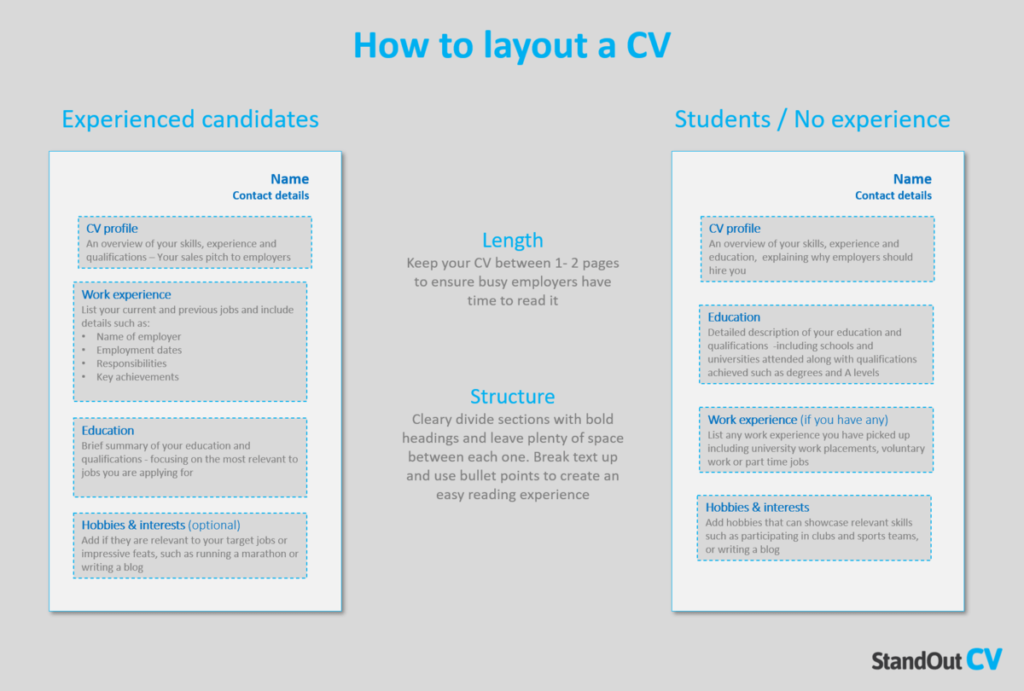The purpose of a CV is to show employers that you are suitable for the jobs you are applying for and persuade them to invite you to interview with them. It is a written document which should include information about your skills, qualifications and work experience.
This guide will tell you everything you need to know about CVs, from what to include and how to design it, through to how you can write one that will secure you plenty of interviews and help you to land that dream job.
What is a CV?
A CV is a concise summary of your work experience, education, and skills provided in a written document.
Most commonly, the purpose of a CV is to display information about a candidate to a prospective employer when searching for a new job. A CV will hold enough information so that an employer can gauge if they want to offer the candidate an interview and proceed to the next stages of the hiring process.


What should a CV look like?
A CV should look professional and be easy for busy employers to read.
No matter how impressive your work history or education is, if you don’t display it in an easy-to-read format, employers may skip past your application. When formatting and styling your CV, pay attention to the following:
- File Format – Use either a PDF or Word document file type
- Clear and Legible Font – This makes it as easy to read as possible
- Clearly Divided Sections – This will allow recruiters to easily distinguish and find the sections they are interested in
- Use a neutral or calm colour scheme – This makes a CV appear professional and easy-to-read
- Avoid images – They take up space and can seem unprofessional
- Use bullet points – These allow for lots of information to be communicated quickly
Above all, a CV should be clear, concise, and well-ordered.
What should a CV include?
Hiring managers need particular information to decide whether or not a candidate is suitable for a job. That considered, you should aim to include the following sections to provide the right level of detail:
- Name and Contact Details – State your mobile number, general location, and email address
- Personal Profile – Surmise your skills, experience, and suitability in 5-8 lines to provide an introduction to your CV
- Work Experience – a succinct summary of your work history, responsibilities, and achievements on the job
- Education – Your education alongside other notable qualifications
- Hobbies – This is optional and should only be included if suitable for the role
How long should a CV be?
In general, a CV should measure two pages or less. That will provide enough room to display your experiences and achievements with justice, while also refraining from overwhelming the prospective employer.
Depending on what you’re applying for, CVs can range in size. If you have years of experience in an industry, your CV will likely be a little longer than normal. The opposite could be true if you are a student or only have a small amount of industry experience.
Who reads your CV?
When applying for a new job, your CV will most frequently be read by a hiring manager or a recruiter.
Hiring Manager – These people oversee the hiring process, looking at your CV and determining if you would be a good fit for the role. Often, they are the leader of the team you will be joining, giving them an insight into exactly what qualities the role needs. They may also oversee any interviews during the process, or delegate this task to another member of the team.
Recruiter – These people are often individuals belonging to a third party, helping hiring managers to find suitable staff for their vacancies. Although they don’t get the final say about who is hired, they will screen CVs and then make a list of recommendations to the company that has hired them. They will handle the job posting, CV scanning, and potentially the interview stages of the application process.
In recent years, employers have also started using ATS computer scanning to filter out CVs that are not suitable for a role. One way to ensure you make the cut is to research the job you’re applying for, then add common keywords to your CV that are placed throughout their job post.
How to send your CV to employers?
Depending on where you found the job posting, the process of sending your CV will vary. Most commonly, you can find jobs on a job website, on a company website, or by sending out a speculative email.
Job websites
Job websites like CV Library host thousands of job adverts which candidates can apply to.
Job adverts on job sites will include a section where you can attach your CV to an application to share it with recruiters and employers. You may also be asked to write a short cover letter before sending your application.
Speculative email
If a company hasn’t posted a job advert, but you believe you could provide a benefit to their company, and they could potentially be looking for people like you, then you should send a speculative email.
These emails will include a formal introduction such as ‘Dear Hiring Manager’ and then explain what work you’re applying for and why you’re the person to do it. Then attach your CV to the email for them to read if they are interested in what you’ve proposed.
Company websites
Many companies have a ‘Jobs’ or ‘Work for Us’ section at the bottom of their website. If you navigate to this page, you’ll see what current job openings they have. If you find one that you’d be a great fit for, you can attach your CV within their website.
Most of the time, they will require a cover letter. This should be written within the body of the page and will include a little about who you are and what you can do for the company. Take a look at some of our example cover letters if you seek more guidance on this part of your application.
Tips for writing a good CV
Now that you understand what a CV should look like and what to include, let’s discuss some top tips for writing a great CV and landing that interview.
Do your research
Every job posting will include job requirements and recommended skills or experience. From this information, you can closely read and pick out relevant skills. be sure to include those qualities throughout your own CV to look highly suitable.
By tailoring your CV to the job post, a potential employer will be able to quickly skim through your application, notice the buzzwords, and recognise that you’ve read their posting.
Make it easy to read
A CV that uses elaborate fonts or has a bad layout will be hard to follow. If a recruiter finds your CV difficult to read, they may likely decide to skip past your application onto one that is clearly set out.
So make your CV pleasant to read by dividing sections clearly with bold headings, breaking up text with bullet points and keeping the formatting simple.
Include quantified achievements
Quantifiable achievements give recruiters clear evidence of how much you have contributed by adding facts and figures
Look at the difference between these two sentences:
- Made the department more efficient over my time there
- Increased department sales by 33% after introducing a new communication tool
The second of the two is more effective as it is a quantified achievement, backed up with numbers. An employer can understand those figures and instantly know how much you achieved in concrete terms.


CV mistakes to avoid
If you want your CV to stand out from the crowd and impress hiring managers, there are three main mistakes you should avoid:
Going over 2 pages
One page is too little to properly expand on why you’re fit for a role. On the flip side, three pages often seems like too much. If you’ve written three pages, take a closer look and search for any superfluous details or sentences that you could shorten or remove.
Using too many clichés
Recruiters come across a huge number of CVs. If you’re using language that you have copied off the internet, you’re probably falling into clichés that don’t actually say much about you.
Instead of saying something like ‘I am a creative person’, try to give an actual example of you displaying this quality. A better way to phrase this would be, ‘I reconfigured my team’s Google Sheets into colour-coded tasks by urgency, reducing late projects by 60%’
Not only is this more interesting to read than a cliché, but it also means that the reader learns something about your skills through a real experience.
Overcomplicating design
When a reader has to struggle to find information on your CV because you have crammed it full of unhelpful features like photos and skills graphs, they will be less inclined to actually read it. Keep things simple, following a methodical structure throughout and focus on communicating your suitability.





